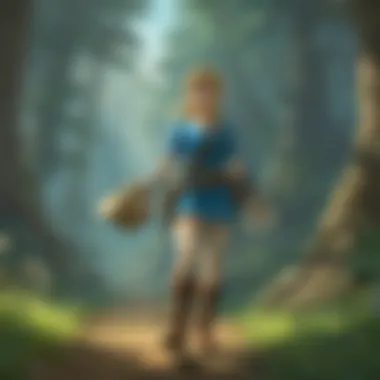Games That Capture the Adventure of Breath of the Wild


Intro
The world of video gaming has a rich tapestry, woven with threads of creativity and innovation. When The Legend of Zelda: Breath of the Wild launched, it wasn't just another game; it was a milestone that set a new benchmark for open-world experiences. Players found themselves captivated not only by the stunning landscapes but also by the freedom to explore them in their own way. The echo of this creation can be felt in several other titles that share similar elements. This article will take you through a selection of games that resonate with the core essence of Breath of the Wild, diving into their gameplay mechanics, storytelling styles, and artistic vibes.
The aim here is not just to present a list but to explore how these games capture that spirit of adventure and discovery. Whether it’s climbing a mountain or solving a puzzle, there’s a sense of satisfaction that permeates through these experiences. If you’re a long-standing fan of the genre, you’ll likely appreciate the depth and nuance in how these titles have embraced open-world gameplay. For casual gamers, this could be a doorway into engaging, richly-crafted worlds that inspire journey and exploration.
Let’s unravel what makes these games shine bright in the realm of video gaming, starting with a streamlined review of each, focusing on gameplay features, storylines, and artistic direction.
Prelims to Open World Exploration
Exploring vast worlds, discovering hidden secrets, and losing oneself in a rich landscape has become an appealing aspect of modern video games. The immersion provided by open world games allows players to engage deeply with the environment, interact with diverse characters, and experience unparalleled freedom in gameplay. This section sets the stage for our discussion of games that resonate with the spirit of Breath of the Wild by examining what exactly makes open world exploration a cornerstone in this genre.
Defining Open World Games
At its core, an open world game is defined by its expansive environments, offering players the liberty to wander and explore almost without restraint. Rather than following a rigid linear path, players can choose their adventure, deciding what they want to focus on and when.
- Freedom of Movement: Players can traverse landscapes at their own pace, climbing mountains, swimming in rivers, and navigating forests without prescribed routes. This open-ended exploration fosters a sense of autonomy rarely found in more structured games.
- Dynamic Environments: The world often reacts to players' decisions, showcasing day-night cycles, changing weather, and wildlife behavior that enhances the sense of realism. For instance, in Breath of the Wild, certain areas become challenging to traverse during storms, compelling players to think strategically.
- Non-linear Storytelling: Open world games typically feature multiple quests that players can undertake in any order. This flexibility in narrative allows for personalized experiences, letting players create their own tales and challenges different from others.
In essence, open world games are about crafting memorable experiences by allowing players to create their own journey, offering them a canvas richer than any static narrative could provide.
The Impact of Breath of the Wild
Breath of the Wild set a new standard in the realm of open world gaming when it launched. Its impact was felt not just in terms of gameplay mechanics but also in how it shaped the expectations of players regarding exploration and interaction with the game world.
"The freedom that Breath of the Wild offers is like opening a window to adventure – you never know what lies ahead, and that keeps you coming back for more."
- Innovative Mechanics: The game introduced innovative mechanics that encouraged exploration. For instance, players could climb almost any surface, which transformed how they approached the environment. This vastly changed how players interacted with the game, as the verticality became a new dimension of exploration.
- Environmental Storytelling: The world of Hyrule is rich in lore, encouraging players to explore every nook and cranny to uncover its history. Players often stumble across ruins, hidden quests, and environmental clues that weave together a larger narrative.
- Influence on Other Titles: The success of Breath of the Wild has greatly influenced how future open world games are designed. Developers now prioritize player autonomy and environmental interaction, often drawing inspiration from the freedom and depth of exploration seen in this title.
In summary, Breath of the Wild not only redefined how players perceive open world games but also inspired new generations of titles, focusing on exploration, creativity, and the natural world. its impact can still be felt across countless games, each echoing the essence of what made Hyrule so captivating.
Key Elements of Gameplay
The fabric that holds together any open-world game often boasts a variety of threads, each representing a distinct gameplay element. These key components — exploration, freedom, puzzle-solving, and combat mechanics — work in concert to construct an immersive experience akin to what players encounter in Breath of the Wild. The importance of these elements lies in their capacity to engage players and offer a sense of satisfaction derived from exploration and discovery.
Exploration and Freedom
In Breath of the Wild, players are enveloped in a world that offers a sense of limitless possibility. This element of exploration allows players to traverse vast landscapes filled with hidden gems, unique creatures, and unexpected challenges.
Exploration leads to discoveries that are both exhilarating and educational. The sheer joy of stumbling upon a serene glade or scaling a monumental peak captures the essence of adventure. In this digital realm, the player’s curiosity often becomes their best ally.
Games echoing this spirit, like Genshin Impact, showcase sprawling worlds that encourage a roam-at-your-own-pace attitude. The game includes environmental puzzles, diverse biomes, and secret treasures that compel players to meander through its landscapes. Freedom in gameplay, such as choosing one’s path, significantly enriches the player experience, as decisions lead to personalized journeys.
Moreover, the dynamic environments often react to player choices, adding layers to the exploration aspect. For instance, Horizon Zero Dawn provides players the ability to engage with fauna and flora in ways that affect both the narrative and gameplay progression. The variety in traversal methods, from gliding over the terrain to scaling cliffs, allows for a multitude of gameplay experiences.
Puzzle Solving and Combat Mechanics
Puzzle solving is where the brains meet brawn. In Breath of the Wild, every corner hides a challenge that necessitates creative thinking. The game’s design brilliantly intertwines puzzles with the environment, compelling players to use the items and abilities at their disposal. Solving a problem might require stacking blocks to reach a ledge or strategically utilizing the elements to interact with the surroundings.
This necessary integration fosters a sense of accomplishment upon finding solutions, boosting cognitive engagement. Titles like Immortals Fenyx Rising employ similar mechanics where players must decode riddles and utilize elemental abilities to intertwine combat with environmental interactions. This melding of mind and skill creates an enriching experience congruent with what players love in Zelda games.
On the combat front, the mechanics must be fluid yet rewarding. Breath of the Wild offers a range of combat styles, enabling players to choose whether to engage directly or strategize from afar. For example, using stealth to take down an enemy or choosing to overwhelm them with speed. The ability to adapt one’s combat style based on the situation is pivotal. Similarly, the Dark Souls series exemplifies rewarding challenge through combat mechanics that encourage perseverance and skill mastery.
"Exploration and combat in games echo the essence of adventure, weaving threads of storytelling into the player experience."
Ultimately, when exploring games that echo the spirit of Breath of the Wild, it becomes clear that the magic often lies in the gameplay elements of exploration and puzzle-solving, paired with engaging combat mechanics. This synergy not only captivates players but also sets a benchmark for future titles that aim to challenge and charm the hearts of adventure seekers.
Games with Similar Aesthetic
The essence of a game often ties closely to its aesthetic—the visuals, sounds, and overall atmosphere contribute to how players absorb the narrative and engage with the world. When discussing titles that echo the spirit of Breath of the Wild, it becomes essential to explore games that not only mimic its open-world exploration but also encapsulate a vibrant aesthetic that captures the imagination. The beauty of these games lies in their ability to draw players into diverse landscapes, often rich with lore, filled with wonder, and layered with meaning. In this context, an aesthetic akin to Breath of the Wild may refer to colorful art styles, compelling world design, and resonant soundscapes that invoke an emotional response, making them perfect counterparts in the adventure genre.
Genshin Impact: A Vast and Enchanting World
Genshin Impact stands tall among games that echo the aesthetic principles of Breath of the Wild. Right from the get-go, players are enveloped in a lush and colorful world known as Teyvat, where every corner holds the allure of discovery. The game flaunts anime-inspired graphics steeped in vivid colors, creating landscapes that feel both inviting and mystical.
Mechanically, Genshin Impact offers fluid exploration much akin to Link’s adventures. Players can climb, swim, and soar through the skies, giving them that same sense of freedom as they'll feel in Hyrule. Each region in Teyvat presents distinct environmental features, from the serene forests of Mondstadt to the grandeur of Liyue’s mountainous terrains. Moreover, the character designs and elemental interaction add layers to gameplay, resonating with the engaging puzzle-solving spirit that Breath of the Wild embodies.


"A beautifully crafted world awaits in Genshin Impact that ensures players stay hooked, not just through action but with every spectacular view."
Horizon Zero Dawn: Nature Meets Technology
In Horizon Zero Dawn, players encounter a hauntingly beautiful world where nature has reclaimed civilization. The art direction is striking, blending lush terrains and futuristic robotic creatures seamlessly. The narrative follows Aloy, a hunter in a world dominated by machines, and challenges the player with exploration and strategic combat.
The juxtaposition of natural beauty with high-tech ruins creates an aesthetic that is not just visually stunning but also thematically rich. The open-world design compels exploration, as gamers traverse vast fields, dense jungles, and majestic mountains in search of resources and secrets. This blend of exploration and environmental storytelling can remind players of their adventures in Breath of the Wild, pushing boundaries of what the world offers in terms of discovery.
Immortals Fenyx Rising: Mythological Adventure
Lastly, Immortals Fenyx Rising captivates with its vibrant art style and humorous take on Greek mythology. The game presents a world of spectacular color and whimsical design, reminiscent of a living painting that invites exploration. The protagonist, Fenyx, embarks on a quest across the Golden Isle, battling mythical creatures and solving ancient puzzles.
What sets this game apart is its light-hearted tone paired with a robust and engaging gameplay system. Players can glide, climb, and navigate in ways that mirror the movement system of Breath of the Wild. The incorporation of gods and mythical artistry wrapped in an open-world format means players will find familiarity wrapped in freshness, encouraging a sense of adventure like no other.
Narrative and Character Development
When it comes to games similar to Breath of the Wild, narrative and character development stand as cornerstones that shape the overall experience. The intricate weaving of story within gameplay does more than simply entertain; it invites players to form emotional connections with characters and immerse themselves into rich, engaging plots. In open-world games, this element becomes particularly significant because the vast landscapes can easily swallow the player into a myriad of adventures, making a compelling narrative essential to keep them anchored.
Good storytelling in games encourages players to forge bonds with characters, making each journey memorable. It creates stakes, where goals become personal and resonant. Think of Link's quest in Breath of the Wild: not only is he saving Hyrule, but players also witness his growth and challenges along the way, fostering a sense of empathy and engagement.
Here’s why narrative and character development are pivotal:
- Emotional Depth: Seamlessly integrates feelings with gameplay, allowing players to experience the highs and lows of the characters.
- Enhanced Player Agency: Stories that adapt or evolve based on player choices improve immersion, giving a sense of ownership over the journey.
- World-Building: A well-crafted narrative enriches the environment; players uncover lore while exploring, adding layers to their adventures.
In summary, narrative and character development are more than mere embellishments—they're vital for creating an experience that resonates long after the game is over.
A Plague Tale: Innocence – Storytelling Through Suffering
A deep dive into A Plague Tale: Innocence reveals a poignant tapestry of hardship, resilience, and the bond between siblings, struggling against overwhelming odds. The story revolves around Amicia and her younger brother Hugo as they navigate a dark, plague-ridden world filled with suffering and danger. Here, the narrative excels in its emotional weight. The game brilliantly expresses the struggles of these two characters through its storytelling, emphasizing moments that tug at the heartstrings.
What makes this narrative particularly interesting is how it relates to darkness and light. The siblings fight not just against the physical manifestations of suffering, such as the swarming rats, but also against despair and hopelessness. This is reflective of the core tenet found in many gameplay mechanics as well—survival against odds, much like the challenges faced in Breath of the Wild. The mechanics of stealth and resource management mirror the emotional stakes, creating an engaging experience that resonates with players deeply.
- Emotional Journey: Players see vulnerability, showcasing how fear and hope intertwine.
- Character Development: Amicia evolves significantly throughout her journey, driven by love and desperation to protect Hugo.
Ultimately, A Plague Tale: Innocence offers a masterclass in how a compelling narrative can elevate gameplay and enhance emotional investment.
Firewatch – Emotion in Isolation
Firewatch stands out as a vibrant example of storytelling through isolation and connection. Set in the breathtaking wilderness of Wyoming, players take on the role of Henry, a fire lookout, who grapples with his own personal troubles while communicating with a fellow lookout, Delilah. This relationship, formed through radio conversations, becomes the backbone of the narrative.
What makes Firewatch striking is its exploration of loneliness paired with the quest for connection. The setting contributes heavily to this theme, as players traverse the beauty of nature, reflecting the contrasts between the stunning landscape and Henry's inner turmoil. As players explore, they uncover layers of both the environment and the characters, making every decision impactful.
- Subtle Storytelling: The narrative unfolds naturally through dialogue and environmental cues, encouraging players to piece together their story.
- Character Complexity: Henry’s dilemmas and communication with Delilah highlight emotional struggles, which resonate strongly with players.
In essence, Firewatch offers a profound meditation on human connection against a backdrop of vast wilderness, echoing the emotional engagement that Breath of the Wild masterfully captures through its own narrative mechanics.
"A well-told story can resonate as deeply as the most beautifully rendered landscapes, capturing not just the player's attention, but their heart."
Crafting and Resource Management
In various games echoing the spirit of Breath of the Wild, crafting and resource management stands as a core pillar. These elements weave together to create a richer gaming experience and encourage exploration and creativity. Players often find themselves gathering materials and utilizing them in unique ways. It's not just about amassing items; it’s the idea of transforming simple components into powerful tools, food, or even weapons. When executed well, crafting systems can enhance immersion and lend a sense of progression throughout the game.
The importance of crafting is clear—it allows players to personalize their gameplay experience. As you adventure through expansive worlds, you might collect various resources: herbs, minerals, or even rare artifacts. With these resources in hand, the possibilities become virtually limitless. You can cook up potions, craft weapons, or build structures that serve a variety of purposes. The balance of resource gathering and crafting often adds an engaging strategic layer to gameplay.
Moreover, effective resource management becomes essential in survival scenarios. Players must juggle limited inventory space against their need to gather more. This not only operationalizes decision-making but also makes the game world feel dynamic. Each journey into the wild requires thought on what to collect and what can be left behind. Situations you face might require you to make tough calls about resource allocation—should you use that last health potion or save it for a tougher fight later?
"Crafting and resource management can turn an average game into an adventure where every item has its place and time."
In this exploration of games resonating with Breath of the Wild, we take a closer look at two prominent titles that shine in this regard, each manifesting the ethos of crafting in different forms: Minecraft and Stardew Valley.
Minecraft: Sandbox and Survival
Minecraft is an emblematic example of modern crafting and resource management, providing players with an enormous sandbox universe to explore, create, and survive. The game’s mechanics invite you to collect blocks and materials, which can then be transformed into everything from simple tools to intricate structures—they can even support complex redstone contraptions.
The simplicity of the game's crafting interface contrasts sharply with the complexity of what you can achieve. Players start by punching trees, collecting wood, and from such humble beginnings, can end up constructing elaborate castles or even working machines. The process emphasizes creativity, allowing for sprawling builds that reflect personal imaginations.


Notably, Minecraft also highlights the strategic element of resource management. Each resource has its rarity and use. For example, diamond is scarce but essential for crafting top-tier gear. Thus, the decision of when to venture into dangerous caves for these precious stones intertwines with crafting strategies and survival tactics, ensuring that no two players' experiences are quite alike.
Stardew Valley: Farming and Community Building
On the other hand, Stardew Valley offers a more nurturing take on crafting and resource management, where players restore a farm left to them by their grandfather. Here, resource management is deeply tied to the rhythm of seasons and community interactions.
Farming begins with gathering seeds, nurturing them into crops, and then harvesting in rhythmic cycles. This process creates a satisfying loop. You must think ahead about which crops to plant based on the season and the resources you have on hand. The friendships you build in the nearby town are also critical, as they offer unique items that can't be crafted just anywhere.
The game encourages you to take on various activities, from fishing to mining, each contributing to a larger tapestry of resource management. The balance of crafting necessities, maintaining livestock, and forging relationships illustrates a multifaceted approach to gathering and building.
In essence, both Minecraft and Stardew Valley capture the spirit of crafting and resource management while offering unique lenses. Each title exemplifies the depth of gameplay that can unfold when players engage with these systems thoughtfully, echoing the adventurous and exploratory nature found in Breath of the Wild.
Combat Systems and Strategies
Combat systems are more than just a means to an end in gaming; they’re a core part of the experience that can define a player’s journey. In the context of open-world games, a well-crafted combat system not only provides challenges but also enhances immersion. Players find themselves adapting strategies, learning from their mistakes, and ultimately feeling a deeper connection to the world around them.
The rich landscapes and varied combat scenarios echo the essence found in The Legend of Zelda: Breath of the Wild, where every encounter can turn the tide of adventure. Just as Link faces formidable foes, players of other titles must strategize, analyze enemy patterns, and utilize their surroundings to triumph.
Here are some key elements to consider regarding combat systems in these games:
- Adaptive Strategies: Players must adapt their approaches depending on the enemies they confront.
- Rewards for Skill: Mastering mechanics grants players satisfaction and builds confidence.
- Tactical Depth: The choices players make influence the flow of the battle.
- Environmental Interaction: Utilizing the environment can provide advantages or lead to creative solutions.
Such elements make the combat experience more than a simple test of strength; they turn each encounter into an opportunity for growth.
Dark Souls Series: Challenging Combat and Rewards
When it comes to combat, few series test players as rigorously as the Dark Souls franchise. Known for its brutally challenging battles, it forces players to rethink how they approach each adversary. Every enemy, from lowly foes to towering bosses, has distinct patterns and weaknesses. This encourages players to engage, observe, and learn rather than rush into combat. The sense of accomplishment after defeating a tricky opponent is profound, reminiscent of the challenges faced in Breath of the Wild.
The combat system capitalizes on a few noteworthy elements:
- Stamina Management: Players must be judicious in their attacks; overextending can lead to dire consequences.
- Timing and Precision: Every strike and dodge necessitates timing, elevating the stakes.
- Risk vs. Reward: High-risk plays can yield substantial rewards, pushing players to delve deeper into their skillsets.
In Dark Souls, it’s not just about battling foes, but learning the intricacies of a labyrinthian world where failure teaches valuable lessons.
The Witcher Series: Strategic Decision Making
The Witcher series stands out with its punctilious blend of tactical combat and narrative-driven choices. Players navigate not just through physical battles but also moral quandaries that shape Geralt's journey. Each combat scenario often plays out in relayed decisions, where players must weigh the consequences of their actions.
Key features of the combat system include:
- Monster Knowledge: Learning about creatures through various means ensures a more effective defeat, a notable parallel to how Link must understand enemy weaknesses.
- Preparation and Strategy: Before entering battles, players gather information and prep potions or spells accordingly, reinforcing the importance of strategy.
- Choices Matter: Every action can significantly influence story arcs and character relationships, layering depth in experiences reminiscent of the choices players face in Breath of the Wild.
Through engaging combat that's echoed with strategic decision-making elements, The Witcher series immerses players into a world where every action bears weight and can lead to unforeseen outcomes.
"Combat in games like Dark Souls and The Witcher doesn't just test skills; it immerses players in worlds that challenge their ability to adapt and make thoughtful decisions."
With these systems, the spirit of exploration and discovery continues to thrive, similar to what players experience in Link's expansive journey. Combat becomes a means of connection, forging bonds between players and the worlds they inhabit.
Exploration in Diverse Settings
The exploration of diverse settings in video games greatly enriches the player experience, acting as a canvas for creativity and engagement. Unlike linear narratives that can feel restrictive, open-world games invite players to wander, discover, and interact with the environment at their own pace. This freedom fosters a sense of wonder and investment in the game world. Players aren't just observers; they become integral parts of a living story that unfolds based on their choices.
There are several crucial elements to consider with this theme:
- Immersive Environments: A diverse setting allows for varied biomes, cultures, and histories to coexist, resulting in a more vibrant world.
- Diverse Gameplay Opportunities: Different landscapes can lead to unique gameplay mechanics, from climbing mountains to sailing seas, each creating fresh challenges.
- Cultural Insights: Games that integrate diverse settings can educate players about different cultures and histories, enhancing the narrative depth and providing context to the characters and quests.
The benefit of this exploration not only lies in entertainment but also in the immersive storytelling that opens the door for players to engage with the broader themes of identity and change.
Assassin’s Creed: Odyssey – Historical Exploration
The vibrant landscapes of Assassin’s Creed: Odyssey transport players to ancient Greece, allowing them to walk among towering temples and traverse the sun-kissed shores of the Aegean Sea. The game is more than just a backdrop; it serves as a gateway to understanding the rich tapestry of Hellenistic culture. Players aren’t merely wandering an empty map; they are stepping into a living history that has depth and soul.
- Educational Value: This title meticulously recreates historical landmarks. One can wander through Athens, visit the Acropolis, or sail to the island of Delos, all while learning about significant events and figures from the era. The attention to historical detail enriches the gameplay and gives players a sense of connection to the past.
- Side Quests Needing Exploration: Many side quests are embedded deep within the environment, urging players to venture off the beaten path. These quests often hold nuggets of wisdom or intriguing lore that flesh out the world and reveal personal stories beyond the main narrative.
- Dynamic Choices and Freedom: In much the same way as Breath of the Wild, players in Odyssey can approach challenges however they like. Whether through combat or clever dialogue choices, every decision alters the course of the story and its outcome.
Ghost of Tsushima: Cultural Richness and Terrain


Similarly, Ghost of Tsushima takes players to feudal Japan, showcasing its sweeping terrains, from lush forests to serene temples. Every location feels steeped in tradition, and the game's attention to the aesthetic details offers a rich cultural experience. Here, exploration is not just a gameplay mechanic; it’s a way to immerse oneself in the very ethos of the samurai code.
- Stunning Visuals and Atmosphere: The art direction and the atmospheric influences create an almost meditative experience, encouraging players to wander and engage with the setting. The visual beauty, combined with natural soundscapes, draws players into its world.
- Cultural Resilience: As players journey through a land under threat, they encounter the philosophical dilemmas of loyalty, honor, and personal responsibility. The game's narratives are deeply tethered to Japanese culture and the tumult of the Mongol invasion, presenting an exploration of both terrain and spirit.
- Environmental Narratives: Much like the wind guiding Jin Sakai to his next goal, exploration in Ghost of Tsushima is fluid. Players often find themselves drawn into spontaneous encounters and situations that feel less scripted and more organic. This dynamic encourages a sense of adventure akin to Breath of the Wild, where every hill and glade could hold a discovery.
"Exploring these settings not only offers players a thrilling adventure but also invites them to reflect on the cultures, histories, and philosophies that shape the narratives they explore."
Innovative Mechanics and Features
The allure of open-world gaming can often be traced back to its innovative mechanics and features. Specifically, in the context of games that echo the essence of Breath of the Wild, these elements play a pivotal role in defining the gameplay experience and immersing players into expansive worlds. Such features help to transcend conventional gameplay, enabling unique interactions and fostering a sense of agency that engages gamers at a deeper level.
One of the standout advantages of these innovative mechanics is their ability to enhance player autonomy. Instead of following a linear path, players can explore at their own pace, crafting their adventures as they see fit. This level of freedom often intertwines with survival aspects, puzzles, and strategic decision-making, making each playthrough distinct. By integrating systems that allow for dynamic exploration and interaction with the environment, developers create worlds that feel alive, brimming with possibilities.
These innovations do not come without their complexities. Developers must balance creativity with functionality, ensuring that the mechanics enhance rather than hinder the gaming experience. Moreover, understanding the audience's expectations plays a crucial role in shaping these features. Players familiar with the depth of Breath of the Wild will seek similarly enriching experiences, so the challenge lies in both meeting and exceeding those expectations.
*"Games must not just be played; they must be experienced. This comes from harnessing innovative mechanics that captivate the player.
Community and Multiplayer Experiences
In the expansive realm of gaming, community and multiplayer experiences hold a significant place, especially in games that embrace the essence of adventure found in The Legend of Zelda: Breath of the Wild. These elements not only enrich the gameplay but also foster social interaction, collaboration, and a shared sense of achievement among players. The unique beauty of such games lies in their ability to create environments where players can embark on epic journeys together, strategize during encounters, and engage in collective problem-solving. It’s this aspect of gaming culture that draws players back in, making them feel part of a larger group rather than mere solitary adventurers.
Benefits of Community and Multiplayer Experiences:
- Enhanced Social Interaction: Playing with others gives an opportunity to build friendships and connect with fellow gamers.
- Diverse Strategies and Perspectives: Collaborating with others offers a wider range of ideas and tactics, potentially leading to new ways to overcome challenges.
- Shared Experiences: Overcoming obstacles as a unit creates memorable moments that can be fondly reminisced upon in the future.
- Increased Replayability: Multiplayer aspects often provide unique content and experiences that single-player modes may not, enticing players to return for more.
Such dynamics are crucial when comparing titles that resonate with Breath of the Wild's spirit. Below are two noteworthy examples that highlight the strengths of community and multiplayer elements in the gaming landscape.
The Legend of Zelda: Four Swords Adventures – Local Multiplayer
In this vibrant installment of the Zelda series, Four Swords Adventures offers a unique local multiplayer experience that allows up to four players to join forces in their quest. Set in a colorful and whimsical world, players assume the roles of various Links as they tackle dungeons, solve puzzles, and defeat enemies together.
The engagement is captivating, as players can aid each other, share items, and strategize unique approaches to challenges. It combines the classic adventure feel of Zelda with cooperative gameplay, encouraging players to communicate and collaborate. The game’s mechanic of needing to work together not only enhances the excitement but also mirrors real-time problem-solving scenarios.
"Playing together brings friends closer, making victories even sweeter and defeats lighter."
However, there lies a balance to strike; cooperation is key, but careless mistakes can lead to unexpected chaos, making for delightful moments of both camaraderie and frustration. With its colorful visual style and charming gameplay, Four Swords Adventures reflects the heartwarming nature of the Zelda franchise while simultaneously enriching multiplayer experience.
Valheim: Cooperative Survival in Norse Mythology
Valheim transports players to a richly designed open world steeped in Norse mythology, where survival is key. This game shines when it comes to cooperative gameplay, allowing friends to band together to build, survive, and explore. Players can share resources, build majestic settlements, and embark on treacherous voyages across unpredictable seas.
The mechanics of Valheim promote teamwork as players must strategize when facing formidable foes like the ancient trolls or the deadly bone mass. The game excels in offering each player the freedom to contribute to the community in their unique way, which can lead to a more personalized experience. Moreover, the shared accomplishments help in forging bonds among players, reinforcing the sense of unity found in community experiences.
While the game is anchored in survival, it also encourages exploration and adventure; each venture into the wild offers new discoveries to be shared among friends. This shared journey replaces the solitary grind typically found in survival games with a community-driven experience that resonates with the spirit of adventure prevalent in Breath of the Wild.
Overall, both Four Swords Adventures and Valheim reinvigorate the multiplayer aspect of gaming, drawing parallels with the cooperative spirit found in Zelda’s gameplay, and cementing their status as engaging titles for cooperative play.
Finale: The Evolving Landscape of Adventure Games
As we wrap up our exploration of games that evoke the spirit of Breath of the Wild, it's clear that the landscape of adventure gaming continues to shift in fascinating ways. The essence of open-world exploration, coupled with intricate storytelling and immersive gameplay mechanics, has established a new standard that many contemporary titles strive to reach. In understanding this evolution, we can appreciate not only the games referenced in this article, but also the broader strides the genre has taken over the years.
Future Trends in Open World Gaming
The directions open-world gaming may take in the future are exciting and varied. For starters, the integration of advanced artificial intelligence could lead to more dynamic interactions within game environments. Imagine characters that remember player choices, thereby affecting how stories unfold or even how quests are structured. This emphasis on personalized narratives could become a mainstay in future titles.
Additionally, we may see lessons from Breath of the Wild influence gameplay mechanics. The physics engine employed by Nintendo, which allows for creative problem-solving, has set a precedent. Future games could expand on this by letting players interact with their surroundings in even more inventive ways.
The role of community and multiplayer may also grow significantly. While some games have experimented with cooperative elements, the trend could evolve into fully integrated multiplayer experiences where communities can shape the world together, thus enhancing engagement and playability.
This not only promises richer experiences but also ensures that adventure games remain relevant in the competitive gaming market.
The Lasting Influence of Breath of the Wild
Breath of the Wild did more than just redefine a franchise; it reshaped our expectations of open-world adventures as a whole. The game's successful marriage of exploration, puzzle-solving, and combat has left an indelible mark on the industry. Titles that follow in its footsteps often find themselves praised for their similar mechanics, yet they also bring their own flavors to the table.
The environmental storytelling employed in Breath of the Wild serves as a benchmark for narrative depth, pushing future developers to think critically about how they weave lore into the gameplay experience. Other games have effectively adopted the formula of discovery through environmental clues, making the journey as fulfilling as the destination.
In essence, the influence of Breath of the Wild is an echo that reverberates through each new game launched, reminding developers and players alike that the heart of adventure gaming lies in the thrill of exploration, the joy of unexpected discovery, and the importance of storytelling that transcends mere dialogue.
"Every land holds a story, waiting for players to uncover its secrets."
In summary, as we look to the future, it is essential to acknowledge how far adventure games have come and where they might head. With Breath of the Wild as a guiding star, the potential for innovation is limitless. This continuing evolution stresses the importance of understanding both the heritage and the future of the genre, making it an exciting time for gamers of all backgrounds.







